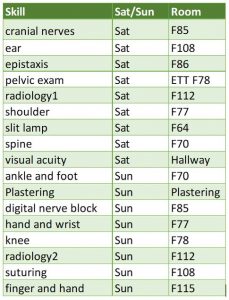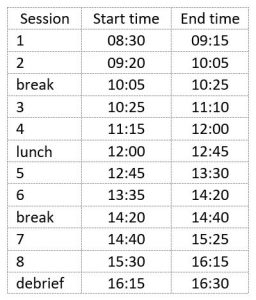Written exam
These instructions are for NZ candidates.
UCPEX written exam is on Friday 20 November 2020. There are multiple locations, and you should refer to email instructions sent to you separately.
- Auckland (MIT Manukau, room 301),
- Hamilton (River room, Pinnacle Health, 711 Victoria Street, Hamilton)
- Wellington (room C05, Otago University Wellington Conference Centre, 23A Mein St, Newtown)
- Christchurch (Pegasus 24 hour surgery, Bealey Ave, room 1.05)
We strongly recommend you arrive by 8.45am. Sign-in and receive your candidate number outside the exam room itself. If you fail to sign in by 9.00am you may not be allowed entry.
We brief you at around 9.15am, reading starts at 9.20am, and the exam at 9.30am. We anticipate letting you leave before 12.00pm
Bring a water bottle which you have with you during the exam. We will ask you to turn all electronic devices (including phones and smartwatches) to silent and put them into a bag. Bags are not allowed at the desks, and we will provide a secure area for them. For any emergencies on the day, please use 02102447070.
Bring pens (we recommend at least two). Do NOT use a red pen, which we reserve for markers.
The exam paper will be on your desk, with the instructions on the front cover. You may read the instructions but do NOT turn pages to read the questions. We allow 10 minutes for reading, and as part of that we ask you to check that the candidate number is on every page of the paper, and to count the number of pages is correct. After the 10 minutes reading time, we will let you know when you can start writing. You have 2 hours for completion.
You may leave anytime up until the final 15 minutes of the allotted time. After that time you will be asked to remain in your seat so as to not disturb others. All papers and paper used to write notes will be handed in. Once the invigilator has checked all papers are collected, you will be invited to leave.
All questions derive from Urgent Care Course material. The answers required are from the course material and what you have learned in utilising and applying the knowledge acquired during the course. There are 83 short answer questions and 17 multiple-choice questions.
Written paper short answer questions
Some questions will call for a certain number of answers. If a candidate gives more than the required number of answers, the UCPEX markers will include the first-given answers and ignore any extra ones.
Common technical mistakes:
- Leaving questions unanswered.
- Illegible answers.
- Not answering the question (For example, when a question calls for management of, or plan for a condition, don’t list clinical history or examination features, or tests you might order to help diagnose the condition. If elements of the history are called for, don’t give examination findings, and vice-versa.)
Please check you’ve answered all questions and that the answers are legible.
If you completely mess up an answer, cross out the answer entirely and put a star against it, along with the letters “PTO”. Write the question number and your answer on the back of that sheet of paper.
Here are some examples of the SAQ:
| What is the general dermatological term for a lesion which is a circumscribed area of change in normal skin colour, with no elevation or depression? | Macule or patch |
| Which internal organ is most likely to be injured following blunt abdominal trauma? | Spleen |
You would write your answer in the space provided to the right of the question.
Written paper multiple choice
An example of the multiple-choice question is:
| Regarding the Ottawa ankle rules, which statement is TRUE? | A) Palpate for tenderness along the posterior rather than anterior aspect of the distal tibia and fibula. B) A patient with malleolar zone pain but no bony tenderness does not require an ankle xray. C) Palpate for bony tenderness in the foot at the base of the 5th metatarsal and at the cuboid. D) They are not for use in children under 5. E) Xrays are indicated if ankle dorsiflexion is less than 30 degrees. |
And you would provide an answer by circling a letter on a separate MCQ answer-sheet supplied. The example below is NOT related to the example question above (ie the answer for the question above is not necessarily C):

Select one answer per question.
Results
The Board of Censors aims to have results to you before 5pm Friday 11 December. We will email you and send a follow-up letter.
The SDAW is designed to assist registrars with learning and demonstrating competence in practical skills. The SDAW focuses on the skills that are critical, commonly done poorly, or for which it is difficult to get instruction.
For some of the stations, specialists have agreed to help by presenting the first two sessions, with the College Fellow present to observe and then take over for the rest of the day. This arrangement allows us to learn from the experts and get the latest top tips, theory, concepts and approaches.
Location and date
Manukau Superclinic, 901 Great South Rd, Manukau, Auckland 2104, this Saturday and Sunday (14 and 15 August).
Timings
Please arrive by 8am
On arrival, please sign in and grab your name badge. Our admin staff will direct you to the ‘module’ where we hold the SDAW. Once there, Dr Matt Wright will greet you and/or someone can show you to your room.
- 8:30-9:25 session 1
- 9:30-10:25 session 2
- 10:30-10:50 Break
- 10:50-11:45 session 3
- 11:50-12:45 session 4
- 12:45-13:30 lunch
- 13:30-14:25 session 5
- 14:30-15:25 session 6
- 15:25-15:40 break
- 1540:16:35 session 7
On Saturday 17:15-18:30 drinks at Lone Star
Stations, Fellows, specialists
| Skill | Sat/Sun | Room | F fname | F lname | S fname | S lname |
| Epistaxis | Sat | F85 | Walid | Waked | ||
| Radiology1 lower limb | Sat | F86 | Kelvin | Ward | ||
| Back examination | Sat | F78 | James | Dryden | ||
| Ankle and foot examination | Sat | F77 | Guy | Melrose | Matt | Debenham |
| Hand and wrist exam | Sat | F67 | Dinesh | Deonarain | ||
| Hand splinting | Sat | F68 | – | – | Odell | Habits |
| Hand spinting | Sat | F68 | – | – | Stephanie | Mitchell |
| ECG | Sat | F70 | Ricardo | D’Souza | ||
| local anaesthetics | Sun | F85 | Dave | Sorrell | Jonathon | Heather |
| shoulder | Sun | F77 | Amanjeet | Toor | Elliot | |
| Slit lamp & visual acuity | Sun | F64 | David | Gollogly | ||
| Plastering | Sun | Downstairs | – | – | Julie | Naden |
| Plastering | Sun | Downstairs | – | – | Jo | Sills |
| Knee examination | Sun | F78 | Andrew | Stacey | Ivan | Spika |
| Radiology2 upper limb | Sun | F86 | Matt | Wright | ||
| Suturing | Sun | F70 | Garsing | Wong | Jonathon | Heather |
F= Fellow demonstrating
S= Specialist/external demonstrating
The specialists have all committed until morning tea (10:05am) and it would be great if they stayed to have a coffee / cup of tea and socialise.
Preparation
Please familiarise yourself with the skills checklist, the equipment provided, and room furniture. If you wish to move furniture around, need more (or less) furniture or equipment, please first find Claire (admin team). She will photograph the room and record where things have been moved from/to. We have to return the module to it’s pre-used state at the end (we’ve had our wrists slapped before so now we attend to this carefully).
The checklists are available in this online shared folder.
Running the station
Dr Wright has communicated separately. Expect groups of up to 6 registrars, each with their own booklet of checklists. Introduce, demonstrate (does not have to be in the order listed), allow time to practise, assess and sign-off as competent if you have time (and the registrar is competent in your opinion).
Refreshments
We will provide coffee, tea and snacks upstairs
Lunch will be provided downstairs in the cafeteria
Please mix and mingle with the registrars as they’d likely be wanting to learn as much as they could
Invoicing and payment
Our College Administrator, Claire, will be in touch about payment. We align with MCNZ rates ($123.60 per hour), and can be paid to you or a charity of your choice.
To be updated prior to SDAW. Currently no observers.
Saturday
All admin should aim to arrive by 7am. First tasks:
- Unload all vehicles and move equipment to correct locations (upstairs, cafeteria).
- Door signs put on doors
- Set up reception and cafeteria by 7.30am – Nat, Afnan, Dayna (one person to stay at reception from 7am)
- Set up upstairs (rooms, equipment to rooms etc) by 8am Adrian, Alex, Hadi, Janse, Andrew
Anticipate:
- registrars arrival from 7.30am (reception, cafe)
- Fellows/specialists arrival around 8am (send to module 7)
Briefing
- AM to brief registrars in cafe at 8am. MW to join to brief on in-room activities
- first up groups, timing buzzer, one station to next, yellow lines, door signs
- AM plus 2 to bring upstairs (groups for different areas)
Upstairs
Each stations’s equipment is in a box for that room.

Downstairs
Reception – sign in sheets, labels
Cafeteria – cups, refreshments, suggestions box, instruction signs
Note – lunch boxes arrive at 11.30am
General timings

Last session
- set up door signs for Sunday
- Move yellow tape
- clear up cafeteria for tomorrow
- expect plastering person to arrive to prepare for tomorrow
At end of Saturday
- Box up Saturday stuff and back to admin area
- Put Sunday boxes in rooms
Expect to be able to depart Saturday by 5pm, and Sunday by 5.30pm (depends how quiickly we can pack up).
Sunday
- arrive by 7.30am
- Reception person from 7.30am
- double check rooms
- pig skins etc for suturing
- brief 8.15am
